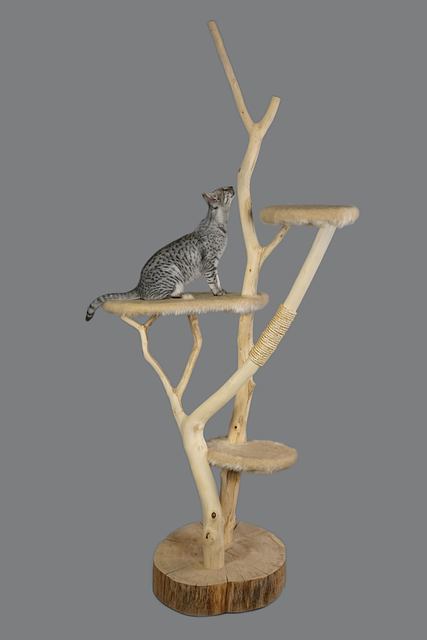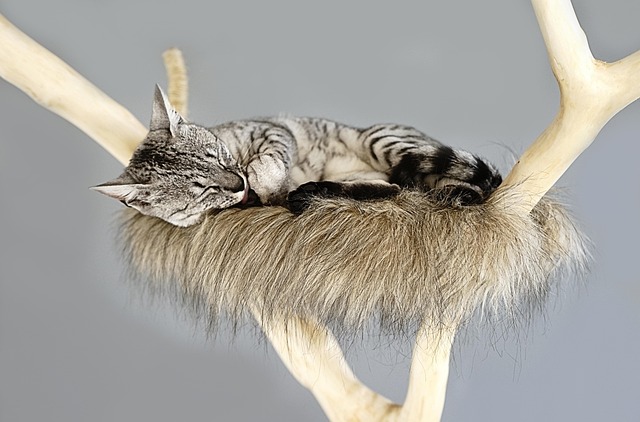To get your cat to use a scratching post instead of furniture, place the scratching post near the furniture your cat has been scratching. Introduce your cat to the scratching post by using catnip or toys to encourage interaction with it.
Additionally, you can also gently guide your cat’s paws to the scratching post to show them how to use it. Consistently reward your cat with treats or praise when they use the scratching post, and consider covering the furniture with double-sided tape or a deterrent spray to discourage scratching.
With patience and positive reinforcement, your cat should start using the scratching post instead of the furniture. Introducing a scratching post to your feline friend is an effective way to redirect their natural scratching behaviour away from your furniture. By strategically placing the scratching post and using positive reinforcement techniques, you can encourage your cat to use the post instead. We will explore simple and practical methods to train your cat to use a scratching post, helping you maintain a scratch-free home while keeping your pet happy and healthy.
The Feline Urge To Scratch
Cats have a instinct to scratch. It’s an innate behaviour deeply rooted in their DNA. Scratching serves multiple purposes for felines, including marking their territory, stretching their muscles, and maintaining healthy claws.
Instincts And Behaviours

Cats are hardwired to scratch. It’s an essential part of their instincts. Providing them with appropriate outlets for this behaviour, such as scratching posts, is crucial in preventing them from targeting furniture and other household items.
Consequences Of Furniture Scratching

The consequences of cats scratching furniture can be costly and frustrating for pet owners. It leads to unsightly damage, potential health hazards from splintered wood or upholstery, and can strain the human-feline relationship.
Choosing The Right Scratching Post
Encourage your cat to use a scratching post by choosing one that matches their preferences. Opt for sturdy posts covered in sisal or carpet, placing them strategically near your cat’s favourite lounging spots. Introduce positive reinforcement and redirect their scratching behaviour to the post with treats or toys.
Cats are adorable furry creatures that love to scratch. They might scratch your sofa or bed, causing damage to your furniture. To prevent that, it’s essential to pick the right scratching post for your feline friend. Here are some crucial factors to consider when selecting a scratching post.
Types Of Scratching Posts

There are various types of scratching posts available in the market. Some popular ones are:
- Vertical scratching posts
- Horizontal scratching posts
- Sisal rope scratching posts
- Cardboard scratching posts
- Scratching pads
Vertical scratching posts are great for cats that love to stretch while scratching. If your cat likes to scratch the carpet or floor, then a horizontal scratching post would be a better fit. Sisal rope scratching posts are durable and perfect for aggressive scratchers. Cardboard scratching posts are cost-effective and are ideal for cats that prefer different textures. Scratching pads are also affordable and can be placed on the floor or hung on the wall.
Material Preferences

Cats have material preferences when it comes to scratching. Some cats like to scratch on rough surfaces, while others prefer smooth ones. Materials like sisal rope, carpet, and wood are popular among cats. However, it’s essential to choose a scratching post made of non-toxic materials. Some cats are allergic to certain materials, so it’s best to observe your cat’s behaviour before buying a scratching post.
Location Matters
The location of the scratching post is crucial. Cats like to scratch in areas where they spend most of their time. Place the scratching post in a visible and accessible location. Avoid placing it in a corner or behind a piece of furniture. If your cat is scratching a specific area, move the scratching post to that location. Additionally, if you have multiple cats, provide each cat with their scratching post.
In conclusion, deciding the right scratching post is crucial to prevent your cat from scratching your furniture. Consider the type of scratching post, material preferences, and location when selecting one. With the right scratching post, your feline friend will be happy and content, and your furniture will be scratch-free.
Introducing The Scratching Post To Your Cat
Encourage your cat to use a scratching post by placing it near their favourite spot. Make it appealing with catnip or toys to redirect their scratching behaviour. Consistent positive reinforcement will help them associate the post with scratching.
First Impressions

Positive Reinforcement Strategies

Training Techniques For Scratching Post Use
Teaching your cat to use a scratching post instead of furniture involves positive reinforcement and redirection techniques. Encourage your cat to use the post by placing it near their favourite resting spots and rewarding them with treats or praise when they use it.
You can also try using catnip to attract them to the post.
Interactive Play Sessions
Engaging in play sessions with your cat near the scratching post can help encourage their use of it.
Use Of Catnip And Treats
Incorporating catnip and treats near the scratching post can motivate your cat to interact with it.
Consistency Is Key
Consistently redirecting your cat to the scratching post and reinforcing positive behaviour is essential for success.
Deterring Scratching On Furniture
Deterring Scratching on Furniture is essential to protect your belongings and maintain a harmonious living environment with your feline friend.
Protective Barriers
Protective barriers can be placed on furniture corners to physically prevent cats from scratching. These barriers are often made of materials like plastic or metal.
Sprays And Deterrents
Sprays and deterrents can be effective in discourageing cats from scratching furniture. Products with bitter tastes or strong scents are commonly used for this purpose.
Redirecting Behaviour
Redirecting behaviour involves providing alternative scratching surfaces like scratching posts or pads. Encouraging your cat to use these alternatives through positive reinforcement is key.
Maintaining Scratching Post Attractiveness
When it comes to maintaining the attractiveness of a scratching post, regular maintenance is essential to ensure your cat continues to use it instead of your furniture. By understanding when to replace a scratching post, you can effectively keep it in prime condition for your feline friend.
Regular Maintenance
Regularly inspect the scratching post for any signs of wear and tear. Trim any loose threads or frayed edges to keep the post looking neat and appealing to your cat. Use a vacuum cleaner or a lint roller to remove any loose fibres or hair that may accumulate on the post.
Consider using catnip spray or attractant to rejuvenate the scratching post’s appeal. Spritzing the post with these scents can entice your cat to use it more frequently.
When To Replace A Scratching Post
It’s important to replace a scratching post when it shows significant signs of damage, such as loose or unstable construction, excessive fraying, or a lack of response from your cat. As a general rule, consider replacing the scratching post every 6 to 12 months, depending on its usage and condition.
Monitoring Progress And Setbacks
To encourage your cat to use a scratching post instead of furniture, monitor its progress and setbacks closely. Pay attention to its behaviour and reward it for using the post. Redirect the cat whenever it tries to scratch the furniture, and be consistent in your training efforts.
Once you have set up your cat’s scratching post and encouraged them to use it, it is important to monitor their progress and setbacks. Keep an eye on your cat’s behaviour and continue to adjust your strategies accordingly. Understanding your cat’s preferences and adjusting your tactics can make a significant difference in helping your cat make the transition from using furniture to using a scratching post.
Understanding Cat’s Preferences
Cats have individual preferences when it comes to scratching. Some prefer vertical scratching posts, while others prefer horizontal scratchers. Some cats like sisal rope, while others prefer carpeted surfaces. It is important to observe your cat’s behaviour to determine their preferences. Place different types of scratching posts and surfaces in different areas of your home to see which ones your cat prefers.
Adjusting Strategies Accordingly
If your cat is not using the scratching post, try different techniques to encourage them. Place the post in an area where your cat spends most of their time. Use positive reinforcement by rewarding your cat with treats or praise when they use the scratching post. If your cat continues to use furniture, try using double-sided tape or aluminium foil on the furniture to deter them.
If your cat is still not using the scratching post, try changing the location or type of scratching post. You may need to try a few different options before finding the one that your cat prefers. Be patient and consistent in your efforts to encourage your cat to use the scratching post.
By monitoring your cat’s progress and setbacks, understanding their preferences, and adjusting your strategies accordingly, you can successfully train your cat to use a scratching post instead of your furniture. With patience and consistency, your cat will learn to love their new scratching post and leave your furniture alone.
Common Mistakes To Avoid
When trying to encourage your cat to use a scratching post instead of your furniture, it’s crucial to be aware of common mistakes that can hinder your efforts. By steering clear of these pitfalls, you can set the stage for success and a harmonious living space for you and your feline friend.
Punishment: A Counterproductive Approach
Refrain from using punishment to deter your cat from scratching furniture. Instead, focus on positive reinforcement and redirection. Punishing your cat can lead to fear and anxiety, which may exacerbate the scratching behaviour.
Neglecting Post Placement And Quality
Ensure that the scratching post is placed in a prominent and accessible location. Additionally, consider the quality and texture of the post. Opt for sturdy, tall posts covered in sisal or corrugated cardboard, as these materials are appealing to cats and mimic the texture of tree bark.
Frequently Asked Questions
How Do I Encourage My Cat To Use A Scratching Post?
Encourage your cat to use a scratching post by placing it near their favourite resting spot. Use catnip to attract them and praise them when they use it. Redirect any scratching on furniture to the post gently.
Why Won’t My Cat Use The Scratching Post?
Cats may not use scratching posts if they prefer other materials or locations. Encourage use by placing treats or catnip nearby.
What Spray Attracts Cats To Scratching Post?
To attract cats to a scratching post, use a catnip spray. It’s a natural, safe, and effective way to encourage scratching. The scent entices cats and directs their scratching behaviour to the post. Regular application can reinforce the positive behaviour.
Do Cats Scratch Furniture If They Have A Scratching Post?
Yes, cats may still scratch furniture even if they have a scratching post. However, providing your cat with a scratching post can help redirect their scratching behaviour and prevent damage to your furniture. It’s important to choose a sturdy and attractive post and place it in a visible and accessible location.
Encourage your cat to use scratching posts by rewarding good behaviour. Consistent positive reinforcement is key to success. Remember, patience is crucial in training your cat. By following these tips, you can protect your furniture and keep your feline friend happy and healthy.
